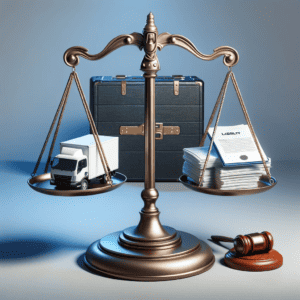
Commercial Auto Insurance – Driving Your Small Business Forward
Commercial Auto Insurance is a crucial aspect of protecting businesses that rely on vehicles for their operations.
Whether it’s a small business with a single delivery van or a large corporation with a fleet of trucks, having the right insurance coverage can provide financial protection in the event of accidents, damage, or theft.
In this article, we will explore the various aspects of commercial auto insurance, including the different types of coverage available, factors that affect insurance rates, tips for choosing the best provider, and steps to take in case of an accident.
We will also discuss how commercial auto insurance relates to liability, workers’ compensation, fleet management, cybersecurity, and risk management.
Understanding Commercial Auto Insurance
Commercial auto insurance is a type of insurance coverage specifically designed for businesses that use vehicles for their operations. It provides financial protection in case of accidents, damage to vehicles, theft, or other incidents involving company-owned vehicles. This type of insurance is essential for businesses as it helps cover the costs associated with vehicle repairs or replacement, medical expenses for injuries sustained in accidents, and legal fees in case of lawsuits.
One key difference between personal auto insurance and commercial auto insurance is the purpose of the vehicle. Personal auto insurance typically covers vehicles used for personal purposes such as commuting to work or running errands. On the other hand, business auto insurance covers vehicles used for business purposes such as transporting goods, making deliveries, or providing services.
Types of Business Auto Insurance Coverage
There are several types of business auto insurance coverage available, and the right one for your business depends on various factors such as the type of business you operate, the size of your fleet, and the specific risks associated with your industry. Here are some common types of coverage:
- Liability coverage: This is the most basic type of commercial auto insurance and is required by law in most states. It covers the costs associated with bodily injury or property damage caused by your company’s vehicles. Liability coverage typically includes both bodily injury liability and property damage liability.
- Collision coverage: This type of coverage helps pay for repairs or replacement of your company’s vehicles if they are damaged in a collision with another vehicle or object, regardless of who is at fault.
- Comprehensive coverage: Comprehensive coverage provides protection against non-collision incidents such as theft, vandalism, fire, or natural disasters. It helps cover the costs of repairing or replacing your vehicles if they are damaged or stolen.
- Uninsured/underinsured motorist coverage: This coverage protects your business if one of your company’s vehicles is involved in an accident with a driver who does not have insurance or does not have enough insurance to cover the damages.
- Cargo coverage: If your business involves transporting goods, cargo coverage is essential. It protects the value of the goods being transported in case of damage or theft.
- Hired and non-owned auto coverage: This type of coverage is for businesses that do not own their vehicles but use rented or employee-owned vehicles for business purposes. It provides liability coverage in case of accidents involving these vehicles.
- Specialized coverage for specific industries: Some industries have unique risks and may require specialized coverage. For example, construction companies may need coverage for equipment attached to their vehicles, while food delivery businesses may need coverage for spoilage of perishable goods.
Factors that Affect Business Auto Insurance Rates

Cost Of Business Auto Insurance
Several factors can affect the rates you pay for business auto insurance. Insurance providers consider these factors when determining the level of risk associated with insuring your business and setting the premiums. Here are some key factors that can impact your insurance rates:
- Driving records of employees: Insurance providers will assess the driving records of all employees who will be driving company vehicles. If you have employees with a history of accidents or traffic violations, it can increase your insurance rates.
- Type of vehicle: The type of vehicle you use for your business can also affect your insurance rates. Vehicles with higher values or those that are more expensive to repair or replace will generally have higher premiums.
- Location of business: The location of your business can impact your insurance rates. If you operate in an area with high traffic congestion or a high rate of accidents, it can increase your premiums.
- Industry and business size: The industry you operate in and the size of your business can also affect your insurance rates. Some industries have higher risks associated with them, such as construction or transportation, which can result in higher premiums.
- Coverage limits and deductibles: The coverage limits and deductibles you choose for your commercial auto insurance policy will also impact your rates. Higher coverage limits and lower deductibles will generally result in higher premiums.
How to Choose the Best Auto Insurance Provider for Your Business
Choosing the right commercial auto insurance provider is crucial to ensure that you have the right coverage at a competitive price. Here are some tips to help you choose the best provider for your business:
- Researching and comparing providers: Take the time to research and compare different insurance providers. Look for providers that specialize in commercial auto insurance and have experience working with businesses in your industry.
- Evaluating coverage options and rates: Consider the specific needs of your business and evaluate the coverage options offered by different providers. Look for a provider that offers comprehensive coverage at a competitive price.
- Checking for financial stability and customer service: It’s important to choose an insurance provider that is financially stable and has a good reputation for customer service. Check the financial ratings of potential providers and read reviews from other customers to get an idea of their reliability and responsiveness.
Tips for Saving Money on Business Auto Insurance
Commercial auto insurance can be a significant expense for businesses, especially those with large fleets. However, there are several ways to save money on insurance premiums without compromising on coverage. Here are some tips to help you save money on commercial auto insurance:
- Bundling policies: Many insurance providers offer discounts for bundling multiple policies. Consider bundling your commercial auto insurance with other types of business insurance, such as general liability or property insurance, to take advantage of these discounts.
- Increasing deductibles: Increasing the deductibles on your commercial auto insurance policy can help lower your premiums. However, be sure to choose a deductible that you can comfortably afford in case of an accident.
- Implementing safety measures: Insurance providers often offer discounts for businesses that implement safety measures to reduce the risk of accidents. Installing safety features such as anti-theft devices, GPS tracking systems, or driver monitoring systems can help lower your premiums.
- Training employees on safe driving practices: Providing training to your employees on safe driving practices can help reduce the risk of accidents and lower your insurance rates. Consider implementing driver safety programs or defensive driving courses for your employees.
What to Do in Case of an Accident: A Step-by-Step Guide
Despite taking all necessary precautions, accidents can still happen. In case of an accident involving one of your company’s vehicles, it’s important to know what steps to take to ensure the safety of everyone involved and protect your business. Here is a step-by-step guide on what to do in case of an accident:
- Ensure safety: The first priority is to ensure the safety of everyone involved in the accident. If there are any injuries, call emergency services immediately.
- Document the accident: Take photos of the accident scene and gather information from all parties involved, including names, contact information, and insurance details.
- Notify the police and your insurance provider: Depending on the severity of the accident, you may need to notify the police. Regardless, it’s important to report the accident to your insurance provider as soon as possible.
- Gather evidence: Collect any evidence that may be useful in determining fault or supporting your insurance claim. This may include witness statements, police reports, or surveillance footage if available.
- File a claim: Contact your insurance provider and file a claim. Provide them with all the necessary information and documentation to support your claim.
- Cooperate with the insurance adjuster: An insurance adjuster will be assigned to handle your claim. Cooperate with them and provide any additional information or documentation they may request.
Commercial Auto Insurance and Liability: Protecting Your Business from Lawsuits

Commercial Auto Insurance and Liability
Liability coverage is a crucial aspect of commercial auto insurance as it protects your business from lawsuits in case of accidents involving your company’s vehicles. Here are some key points to understand about liability coverage:
- Types of liability coverage: Liability coverage typically includes both bodily injury liability and property damage liability. Bodily injury liability covers the costs associated with injuries sustained by others in an accident caused by your company’s vehicles. Property damage liability covers the costs of repairing or replacing other people’s property that is damaged in an accident caused by your company’s vehicles.
- How liability coverage works: If an accident occurs and you are found at fault, liability coverage will help cover the costs associated with injuries or property damage sustained by others. This can include medical expenses, lost wages, pain and suffering, and legal fees if a lawsuit is filed against your business.
- Examples of lawsuits and claims covered by liability insurance: Liability coverage can protect your business from various types of lawsuits and claims. For example, if one of your company’s vehicles causes an accident that results in injuries to another driver, they may file a lawsuit seeking compensation for medical expenses, lost wages, and other damages. Liability coverage can help cover the costs associated with defending against the lawsuit and paying any damages awarded.
Commercial Auto and Workers’ Compensation: What You Need to Know
Workers’ compensation is a type of insurance that provides benefits to employees who are injured or become ill as a result of their work. It is a separate insurance policy from commercial auto insurance, but the two are closely related when it comes to accidents involving company vehicles. Here’s what you need to know about workers’ compensation and how it relates to commercial auto insurance:
- How workers’ compensation works: Workers’ compensation provides benefits to employees who are injured or become ill as a result of their work. These benefits typically include medical expenses, lost wages, and rehabilitation costs. Workers’ compensation is a no-fault system, meaning that employees are entitled to benefits regardless of who is at fault for the accident.
- How it relates to commercial auto insurance: If an employee is injured in an accident involving a company vehicle, they may be eligible for workers’ compensation benefits. Workers’ compensation will cover their medical expenses and lost wages, regardless of whether the accident was caused by the employee or another driver.
- Examples of injuries covered by workers’ compensation: Workers’ compensation can cover a wide range of injuries sustained in accidents involving company vehicles. This can include injuries such as broken bones, back injuries, head injuries, or even psychological trauma resulting from the accident.
Fleet Management: Best Practices for Business Owners

Fleet Management
Fleet management is an essential aspect of running a business that relies on vehicles for its operations. Proper fleet management can help reduce costs, improve efficiency, and ensure the safety of your drivers and vehicles. Here are some best practices for business owners when it comes to fleet management:
- Importance of fleet management: Effective fleet management involves overseeing all aspects of your company’s vehicles, including maintenance, fuel efficiency, driver safety, and compliance with regulations. Proper fleet management can help reduce costs, improve productivity, and minimize the risk of accidents or breakdowns.
- Tips for maintaining vehicles: Regular maintenance is crucial to keep your vehicles in good working condition and prevent breakdowns. Implement a preventive maintenance program that includes regular inspections, oil changes, tire rotations, and other necessary maintenance tasks.
- Implementing driver safety policies: Establish clear policies and procedures for your drivers to ensure their safety and the safety of others on the road. This can include guidelines for safe driving practices, restrictions on cell phone use while driving, and mandatory driver training programs.
Minimizing Risks and Maximizing Protection
Risk management is an essential aspect of running a business that relies on vehicles. Proper risk management can help minimize the risks associated with accidents, damage, theft, or other incidents involving company vehicles. Here’s what you need to know about risk management and how it relates to commercial auto insurance:
- Importance of risk management: Risk management involves identifying, assessing, and mitigating risks to protect your business and its assets. Proper risk management can help minimize the financial impact of accidents or other incidents involving company vehicles.
- Identifying and assessing risks: Start by identifying the potential risks associated with your business’s use of vehicles. This can include risks such as accidents, theft, damage to vehicles or cargo, or liability claims. Assess the likelihood and potential impact of each risk to prioritize your risk management efforts.
- Implementing risk management strategies: Once you have identified and assessed the risks, implement strategies to mitigate them. This can include implementing safety measures, training employees on safe driving practices, conducting regular vehicle inspections, and ensuring proper insurance coverage.
Conclusion
Commercial auto insurance is a crucial aspect of protecting businesses that rely on vehicles for their operations. It provides financial protection in case of accidents, damage, theft, or other incidents involving company-owned vehicles.
Understanding the different types of coverage available, factors that affect insurance rates, and best practices for fleet management can help businesses make informed decisions when it comes to choosing the right insurance provider and implementing risk management strategies.
By taking the necessary steps to protect their business and employees, businesses can ensure that they have the right coverage in place to handle any unforeseen events that may arise.





